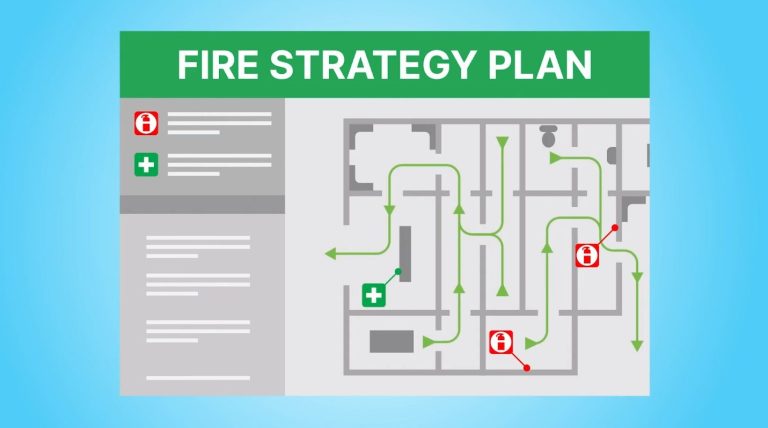Fire Risk Assessments from Just £139
Fire Strategy
Comprehensive Fire Strategy Solutions
A fire strategy is a complex document specifically tailored to a building, reviewing all aspects of the building’s fire safety features including construction, compartmentation strategy, means of escape, and other fire safety features/measures—along with management arrangements to ensure it aligns with the intended use of the premises. Approved documents serve predominantly as guidance for achieving the requirements of the Building Regulations for new residential and commercial buildings; however, they are not legally enforced, unlike the Building Regulations. Alternative approaches may be used, such as those described in BS 9999, or a fire engineered approach in developing a fire strategy for a premises.
Is a Fire Strategy a Legal Requirement?
When a building is erected or extended, or undergoes a material change of use, Regulation 38 of the Building Regulations mandates that a package of fire safety information must be compiled and provided to the responsible person of the premises. A fire strategy is commonly used to collate and provide this information. However, in many cases, this documentation is regrettably not provided. Enlightened building owners, considering the recommendations from the post-Grenfell Hackitt Review, are now commissioning retrospective strategies to address this information gap.
How Does a Fire Strategy Improve My Business Resilience?
Implementing a fire strategy will protect business procedures and assets by analysing potential fire spread and formulating a plan to minimise fire damage. A fire strategy can be effectively used alongside a business continuity plan, a pre-planned management system to ensure a company can continue to operate after a disaster, such as fire. This is a vital aspect of fire safety consultancy and contributes to robust risk assessment services and overall property safety management.
Why Choose KARFM Ltd for Your Fire Strategy Needs?
- Years of experience in fire safety consultancy and building compliance services
- Comprehensive risk assessment services for properties across the United Kingdom
- Expertise in facility management solutions and estate management companies
- Skilled in conducting health and safety audits
- Personalized approach to fire risk management
Contact KARFM Ltd at compliance@karfm.co.uk or call us on: 0151 3081830. Our office is located at Aintree Building, Aintree Way, Aintree, Liverpool L9 5AQ, UK, within the Aintree Industrial Estate. Trust KARFM Ltd for tailored, effective fire strategies that prioritize your property’s safety and compliance.



Fire Strategy
A fire strategy is a complex document specifically tailored to a building, reviewing all aspects of the building’s fire safety features including construction, compartmentation strategy, means of escape and other fire safety features/measures - including management arrangements in place to ensure it is fit for use for the end user of the premises or intended purpose group. Approved documents are used predominantly as guidance for achieving the requirements of the Building Regulations for new residential and commercial buildings: however, they are not lawfully enforced, unlike the Building Regulations. Alternatively, associated approaches may be used such as that described in BS 9999, or a fire engineered approach in developing a fire strategy for a premises.
Is a fire strategy a legal requirement?
Where a building is erected or extended, or has undergone a material change of use, Regulation 38 of the Building Regulations requires that a package of fire safety information must be assembled and given to the responsible person of the premises. A fire strategy is commonly used as a means for collating and providing that information - albeit in many circumstances such information is sadly not provided. More enlightened building owners, given the recommendations made in the post Grenfell Hackitt Review, are now commissioning retrospective strategies to address this lack of information.
How does a fire strategy improve my business resilience?
Completing a fire strategy will protect business procedures and assets by analysing potential fire spread and implementing a plan to minimise the destruction caused by a fire. The fire strategy can be used alongside a business continuity plan, which is a pre-planned management system implemented to ensure a company can continue to operate after a disaster such as fire, flood or any other natural occurrence.
What is included in a fire strategy?
- means of warning – analysing the standard of fire detection required for the premises, is the premises required to be linked to an alarm receiving centre in order for the soonest possible arrival of the fire and rescue service where other actions are required to be taken automatically in the event the alarm is raised, are they effectively implemented and interfaces with the alarm and detection system suitably established (such as for the release of fire doors, fail safe for secured doors to open, or impacts on ventilation systems to prevent the spread of smoke etc)
- means of escape – analysing the travel distances and whether the existing escape routes leading to a place of ultimate safety are suitable and sufficient for all persons at risk in the premises and the intended capacities. Provision of emergency/external lighting and signs to aid escape, as well as emergency plans displaying designated evacuation routes do escape routes lead to a place of ultimate safety?
- internal fire spread/passive fire protection – analysing that the level of internal protection required along escape routes (including protected routes, fire doors, the treatment of service penetrations and joints in construction) is necessary in order to ensure fire separation is achieved to aid safe evacuation, and meet other fire safety objectives including those required by Building Regulations (such as for maximum compartment size) or those implemented at the behest of the building owner/operator (such as to protect areas of high financial or strategic value) consideration should also be made of specific requirements for linings to ensure that surface flame spread is effectively minimised – is the existing compartmentation satisfactory?
- external fire spread – analysing the possible degree of further damage should the fire spread externally via breakout, across roofs, via cladding or other materials used on the external envelope, or through the transfer of heat to adjacent buildings
- access/facilities for the FRS – ensuring all provisions satisfy both the Building Regulations and the local fire authority, which includes reviewing external vehicle access; hydrants; and establishing if there is a requirement for rising fire mains, access points, firefighting lifts etcetera
- other factors – these may include the use of sprinkler or other suppression systems, smoke control and ventilation systems and such like the implementation of such systems may be used to compensate in a building with increased risks present, such as extended travel distances, limited means of escape, large compartment sizes or significant life risk (such as in healthcare) - commonly in such circumstances, an approach in line with BS 9999 or a fire engineered solution will be implemented
- Fire safety management for the building – including the adopted evacuation strategy and fire safety training specific to the building staff employed to work there, addressing any specific fire risks within the premises and detailing particular duties which should be performed during an evacuation for certain staff company policy and procedures to be implemented, such as maintaining compliance with fire risk assessments; maintenance and testing of internal systems; implementing competent person fire door checks; arranging planned preventative maintenance (PPM) schedules for the fire protection systems and any other relevant services; management of contractors and creating hot work permits etc.
Who should create a fire strategy?
Fire strategies should only be developed by a competent person with comprehensive training and experience - preferably an accredited fire risk assessor or fire engineer, depending on the complexity of the building and the design approach implemented (if known).
For the vast majority of premises where a relatively simple prescriptive approach is utilised to ensure that the requirements of Building Regulations have been met a competent fire risk assessor or consultant will be able to advise. Similarly this will be the case for more complex circumstances where the approach described in BS9999 or BS9991 has been implemented.
We need your consent to load the translations
We use a third-party service to translate the website content that may collect data about your activity. Please review the details in the privacy policy and accept the service to view the translations.




